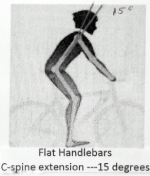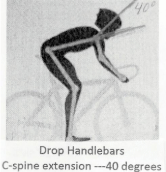
Short Communication
Austin J Orthopade & Rheumatol. 2016; 3(1): 1028.
Cyclist Neck
Manes HR1* and Wolfson N2
1Department of Orthopedics-Queens Surgical Center, New York
2Robert Woods Johnson University Hospital, New York
*Corresponding author: Harvey R. Manes, Department of Orthopedics-Queens Surgical Center, New York
Received: May 20, 2016; Accepted: June 06, 2016; Published: June 08, 2016
Abstract
A comparison of the incidence of cervical spine degeneration in bicyclist that use drop handlebars (bull whips) versus cervical spine degeneration in bicyclist that use flat (standard) handlebars.
Short Communication
In order to reduce wind resistance, most experienced or competitive cyclists ride bicycles that have dropped handlebars (bullwhips) which force the C-spine into a position of approximately 35- 45 degrees of hyper-extension. This position is held continuously for the duration of the ride which could last for several hours. In comparison, the standard or flat handlebars only place the cervical spine in 10-15 degrees of extension (Figures 1 & 2). As a result, the C-spine may develop premature degeneration in those cyclists using drop handlebars, resulting in a condition to be called as “Cyclist Neck”. This article compares the incidence of c-spine degeneration in cyclist that use drop handlebars versus those cyclist that use flat handlebars. There are no other articles in the literature that broach this subject.
Method
100 male bicyclists from the L.I. Bicycle Club, Huntington Bicycle Club, and Suffolk Bicycling Riders Association were randomly picked out of approximately 1000 members. The age group was 35- 42, otherwise healthy and had never been diagnosed with arthritis. Only those bicyclists who ride at least twice per week, minimum 2 hours per ride, for at least 10 years were included in the study. 50 male cyclists who use drop (bull whip) handlebars were compared to 50 male cyclists (1) using standard flat (upright) handlebars to determine evidence of degenerative cervical spine disease based on plain x-ray examination including a/p, lateral and oblique views. Degeneration consists of narrowing of the joint space, osteophyte formation, facet hypertrophy, and sclerosis of vertebral end plates [1- 3]. The X-rays were read by an orthopedist and a radiologist. If there was a difference in judgment a third radiologist was consulted. The age group was 35-42. Only those bicyclists who ride at least twice per week, minimum 2 hours per ride, for at least 10 years were included in the study. Clinical signs and symptoms of cervical spondylosis were not studied in this article.

Figure 1: Flat handlebars.

Figure : Drop handlebars.
Results
In this study the incidence of c-spine degeneration in cyclists using standard flat handlebars was 30% (15 out of 50). The incidence of degeneration in those cyclists using drop handlebars increased to 46% (23 out of 50). That is an increase of 53%.
Discussion
Most experienced or competitive bicyclist tends to use drop handlebars so that there is a reduction in the wind resistance and therefore less energy is needed to go faster [4]. The upright handlebars create a higher wind resistance and therefore more energy is required to go the same speed and distance. However, the drawback by using this type of handlebar is the extreme neck hyper-extension (35-45degrees) that is required in order to see the road. In the normal population of 35-42 year old men, the prevalence of c-spine degeneration is approximately 25-37% [5-7]. By keeping the neck in this unnatural position for extended periods of time, there is increase wear and tear on the c-spine and therefore according to this study an increase in cervical spinal degeneration of 53%.
Conclusion
This study finds that cyclist that use drop handlebars have an increased chance of cervical spine degeneration of 53%. Therefore cyclists should be warned of the risks of using drop handlebars.
References
- Kellgren JH, Lawrence JS. Osteo-arthrosis and disk degeneration in an urban population. Ann Rheum Dis. 1958; 17: 388-397.
- Lehto IJ, Tertti MO, Komu ME, Paajanen EK, Tuominen J, Kormano MJ. Age-Related MRI Changes at 0.1 T in Cervical Discs in Asymptomatic subjects, Neuroradiology. 1994; 36: 49-53.
- Friedenberg ZB, Miller WT. Degenerative disc disease of the cervical spine. J Bone Joint Surg Am. 1963; 45: 1171-1178.
- Richmond DR. Handlebar Problems in Bicycling, Clinical Sports Med. 1994; 13: 165-173.
- Lawrence JS. Disc degeneration. Its frequency and relationship to symptoms. Ann Rheum Dis. 1969; 28: 121-138.
- Matsumoto M, Fujimura N, Suzuki N, Nishi Y, Nakamura M, Yabe Y, et al. MRI of cervical discs in asymptomatic subjects, JBJS. 1998; 80: 19-24.
- Boden SD, McCowin PR, Davis DO, Dina TS, Mark AS, Wiesel S. Abnormal MRI of the cervical spine in asymptomatic subjects, JBJS. 1990; 72: 1178-1184.